Numerical Investigation of a Local Precise Reinforcement Method for Dynamic Stability of Rock Slope under Earthquakes Using Continuum–Discontinuum Element Method
Abstract
:1. Introduction
2. Methodology
2.1. Case Study
2.2. Basic Principles of Numerical Model Calculation
3. Results
3.1. Evaluation of Slope Stability after Partial Reinforcement
3.2. Dynamic Response Characteristics of the Partially Reinforced Slope
3.3. Damage State Assessment of the Partially Reinforced Slope
4. Discussion
5. Conclusions
- The local precision reinforcement method for the seismic damage of slopes is proposed, and the main content of the local precision reinforcement method is expounded. To find out the distribution and evolution characteristics of the seismic damage of slopes under earthquakes is the premise of reducing the local reinforcement of slopes. The displacement distribution of slopes under earthquakes shows that the displacement of an anti-dip slope is large at the slope toe, crest and shallow surface, and these three areas are the key reinforcement areas. By comparing PGA and PGD of cases, it was found that PGA characteristics of different models changed obviously with the change of elevation, and PGD showed an increase phenomenon as a whole with the increase in elevation. The local and overall reinforcement of slopes changed the distribution characteristics of the dynamic acceleration amplification effect of slopes, but did not significantly change the variation trend of PGD.
- The local precision reinforcement method does not always carry out infinite reinforcement, but should strictly control the local precision reinforcement times of slopes combined with the actual situation. When the number of reinforcements increases, the engineering problem of excessive reinforcement will occur, which not only wastes manpower and material resources, but also weakens the reinforcement effect. The maximum displacement from Case 1 to Case 4 of the slope decreases gradually, while the maximum displacement of Case 5 increases rapidly. This indicates that the first three times local precise reinforcement is performed the effect is better, but when local reinforcement is performed more than three times, the reinforcement effect of the slope gradually becomes worse.
- The dynamic response and seismic damage characteristics of different local precise reinforcement schemes and overall reinforcement schemes are compared and analyzed. Based on the analysis of the PGA, PGD, equivalent crack ratio and block energy of the slopes, the dynamic amplification effect decreases obviously after local precise reinforcement. In particular, the dynamic amplification effect and damage distribution characteristics of Case 4 after three times of local grouting reinforcement are similar to those of Case 6 after overall reinforcement. This indicates that the effect of local precision reinforcement is similar to that of integral reinforcement, that is, the local precision reinforcement method has good feasibility and effectiveness.
Author Contributions
Funding
Institutional Review Board Statement
Informed Consent Statement
Data Availability Statement
Conflicts of Interest
References
- Chen, Z.; Song, D.Q.; Dong, L.H. Characteristics and emergency mitigation of the 2018 Laochang landslide in Tianquan County, Sichuan Province, China. Sci. Rep. 2021, 11, 1578. [Google Scholar] [CrossRef] [PubMed]
- Chen, Z.; Song, D.Q.; Hu, C.; Ke, Y.T. The September 16 2017, Linjiabang landslide in Wanyuan County, China: Preliminary investigation and emergency mitigation. Landslides 2020, 17, 191–204. [Google Scholar] [CrossRef]
- Hakim, W.L.; Rezaie, F.; Nur, A.S.; Panahi, M.; Khosravi, K.; Lee, C.W.; Lee, S. Convolutional neural network (CNN) with metaheuristic optimization algorithms for landslide susceptibility mapping in icheon, south korea. J. Environ. Manag. 2022, 305, 114367. [Google Scholar] [CrossRef] [PubMed]
- Sakurai, A.; Sato, T.; Murayama, Y. Impact evaluation of a school-based disaster education program in a city affected by the 2011 great east japan earthquake and tsunami disaster. Int. J. Disaster Risk Reduct. 2020, 47, 101632. [Google Scholar] [CrossRef]
- Yulianto, E.; Utari, P.; Satyawan, I.A. Communication technology support in disaster-prone areas: Case study of earthquake, tsunami and liquefaction in palu, indonesia. Int. J. Disaster Risk Reduct. 2020, 45, 101457. [Google Scholar] [CrossRef]
- Pang, H.P.; Nie, X.P.; Sun, Z.B.; Hou, C.Q.; Dias, D.; Wei, B.X. Upper bound analysis of 3d-reinforced slope stability subjected to pore-water pressure. Int. J. Geomech. 2020, 20, 06020002. [Google Scholar] [CrossRef]
- Frydrych, M.; Kacprzak, G.; Nowak, P. Hazard reduction in deep excavations execution. Sustainability 2022, 14, 868. [Google Scholar] [CrossRef]
- Schwerdt, S.; Mirschel, D.; Hildebrandt, T.; Wilke, M.; Schneider, P. Substitute building materials in geogrid-reinforced soil structures. Sustainability 2021, 13, 12519. [Google Scholar] [CrossRef]
- Bordoloi, S.; Ng, C. The effects of vegetation traits and their stability functions in bio-engineered slopes: A perspective review. Eng. Geol. 2020, 275, 105742. [Google Scholar] [CrossRef]
- Blondeau, S.; Gunnell, Y.; Jarman, D. Rock slope failure in the western alps: A first comprehensive inventory and spatial analysis. Geomorphology 2021, 380, 107622. [Google Scholar] [CrossRef]
- Chen, Z.; Song, D.Q.; Juliev MPourghasemi, H.R. Landslide susceptibility mapping using statistical bivariate models and their hybrid with normalized spatial-correlated scale index and weighted calibrated landslide potential model. Environ. Earth Sci. 2021, 80, 324. [Google Scholar] [CrossRef]
- Abdekareem, M.; Al-Arifi, N.; Abdalla, F.; Mansour, A.; El-Baz, F. Fusion of remote sensing data using GIS-based AHP-weighted overlay techniques for groundwater sustainability in arid regions. Sustainability 2022, 14, 7871. [Google Scholar] [CrossRef]
- Ma, K.; Tang, C.A.; Liang, Z.Z.; Zhuang, D.Y.; Zhang, Q.B. Stability analysis and reinforcement evaluation of high-steep rock slope by microseismic monitoring. Eng. Geol. 2017, 218, 22–38. [Google Scholar] [CrossRef]
- Liu, J.; Chen, Z.H.; Kanungo, D.P.; Song, Z.Z.; Bai, Y.X.; Wang, Y.; Li, D.; Qian, W. Topsoil reinforcement of sandy slope for preventing erosion using water-based polyurethane soil stabilizer. Eng. Geol. 2019, 252, 125–135. [Google Scholar] [CrossRef]
- Fan, G.; Zhang, J.J.; Qi, S.C.; Wu, J.B. Dynamic response of a slope reinforced by double-row antisliding piles and pre-stressed anchor cables. J. Mt. Sci. 2019, 16, 226–241. [Google Scholar] [CrossRef]
- Chen, W.; Li, D.B.; Ma, T.; Fu, H.L.; Du, Y.P. Stability analysis of a slope considering two reinforcement processes. Geofluids 2020, 816, 8828747. [Google Scholar] [CrossRef]
- Wang, F.F.; Shao, J.G.; Li, W.K.; Wang, Y.F.; Wang, L.F.; Liu, H.L. Study on the effect of pile foundation reinforcement of embankment on slope of soft soil. Sustainability 2022, 14, 14359. [Google Scholar] [CrossRef]
- Li, X.Y.; Qin, Z.P.; Tian, Y.; Zhang, H.W.; Zhao, H.T.; Shen, J.F.; Shao, W.L.; Jiang, G.R.; Guo, X.D.; Zhang, J.S. Study on stability and ecological restoration of soil-covered rocky slope of an abandoned mine on an island in rainy regions. Sustainability 2022, 14, 12959. [Google Scholar] [CrossRef]
- Zhang, R.; Tang, P.X.; Lan, T.; Liu, Z.J.; Ling, S.G. Resilient and Sustainability Analysis of Flexible Supporting Structure of Expansive Soil Slope. Sustainability 2022, 14, 12813. [Google Scholar] [CrossRef]
- Zhang, S.; Zhang, G.; Zhang, X.; Chen, L.; Zheng, S. Influences on antislide piles used for slope reinforcement: Numerical simulation based on the soil arching effect. Math. Probl. Eng. 2020, 2020, 7651080. [Google Scholar] [CrossRef]
- Liu, D.; Hu, X.; Zhou, C.; Xu, C.; Wang, Q. Deformation mechanisms and evolution of a pile-reinforced landslide under long-term reservoir operation. Eng. Geol. 2020, 275, 105747. [Google Scholar] [CrossRef]
- Meijer, G.J.; Bengough, A.G.; Knappett, J.A.; Loades, K.W.; Nicoll, B.C. In situ measurement of root reinforcement using corkscrew extraction method. Can. Geotech. J. 2018, 55, 1372–1390. [Google Scholar] [CrossRef] [Green Version]
- Sciegaj, A.; Larsson, F.; Lundgren, K.; Runesson, K. On a volume averaged measure of macroscopic reinforcement slip in two-scale modeling of reinforced concrete. Int. J. Numer. Methods Eng. 2019, 121, 1822–1846. [Google Scholar] [CrossRef]
- Song, D.Q.; Liu, X.; Huang, J.; Wang, E.Z.; Zhang, J.M. Characteristics of wave propagation through rock mass slopes with weak structural planes and their impacts on the seismic response characteristics of slopes: A case study in the middle reaches of Jinsha River. Bull. Eng. Geol. Environ. 2021, 80, 1317–1334. [Google Scholar] [CrossRef]
- Du, H.; Song, D.Q. Investigation of failure prediction of open-pit coal mine landslides containing complex geological structures using the inverse velocity method. Nat. Hazards 2022, 111, 2819–2854. [Google Scholar] [CrossRef]
- Feng, W.; Tang, Y.; Hong, B. Landslide Hazard Assessment Methods along Fault Zones Based on Multiple Working Conditions: A Case Study of the Lixian–Luojiabu Fault Zone in Gansu Province (China). Sustainability 2022, 14, 8098. [Google Scholar] [CrossRef]
- Solórzano, J.; Morante-Carballo, F.; Montalván-Burbano, N.; Briones-Bitar, J.; Carrión-Mero, P. A Systematic Review of the Relationship between Geotechnics and Disasters. Sustainability 2022, 14, 12835. [Google Scholar] [CrossRef]
- Shu, H.; Guo, Z.; Qi, S.; Song, D.Q.; Pourghasemi, H.R.; Ma, J. Integrating Landslide Typology with Weighted Frequency Ratio Model for Landslide Susceptibility Mapping: A Case Study from Lanzhou City of Northwestern China. Remote Sens. 2021, 13, 3623. [Google Scholar] [CrossRef]
- O’Connor, W.; Mider, G.; Lawrence, J.A.; Agar, S.; Mason, P.J.; Ghail, R.; Scoular, J. An Investigation into Ground Movement on the Ventnor Landslide Complex, UK Using Persistent Scatterer Interferometry. Remote Sens. 2021, 13, 3711. [Google Scholar] [CrossRef]
- Zhang, J.; Li, W.; Ye, S. Stability Analysis of Filled-Slope Reinforced by Frame with Prestressed Anchor-Plates under Static Action. Appl. Sci. 2023, 13, 1615. [Google Scholar]
- Wang, J.; Liu, P.; Si, P.; Li, H.; Wu, F.; Su, Y.; Long, Y.; Cao, A.; Sun, Y.; Zhang, Q. Three-Dimensional Stability Analysis of Ridge Slope Using Strength Reduction Method Based on Unified Strength Criterion. Appl. Sci. 2023, 13, 1580. [Google Scholar] [CrossRef]
- Feng, C.; Li, S.H.; Hao, W.H.; Ge, W. Numerical simulation for penetrating and blasting process of epw based on cdem. J. Vib. Shock 2017, 36, 11–18. [Google Scholar]
- Zhang, Q.L.; Zhi, Z.H.; Feng, C.; Cai, Y.C.; Pang, G.H.; Yue, J.C. Investigation of concrete pavement cracking under multi-head impact loading via the continuum-discontinuum element method. Int. J. Impact Eng. 2020, 135, 103410.1–103410.13. [Google Scholar] [CrossRef]
- Wang, C.W.; Liu, X.L.; Song, D.Q.; Wang, E.Z.; Zhang, J.M. Numerical investigation on dynamic response and failure modes of rock slopes with weak interlayers using continuum discontinuum element method. Front. Earth Sci. 2021, 9, 791458. [Google Scholar] [CrossRef]

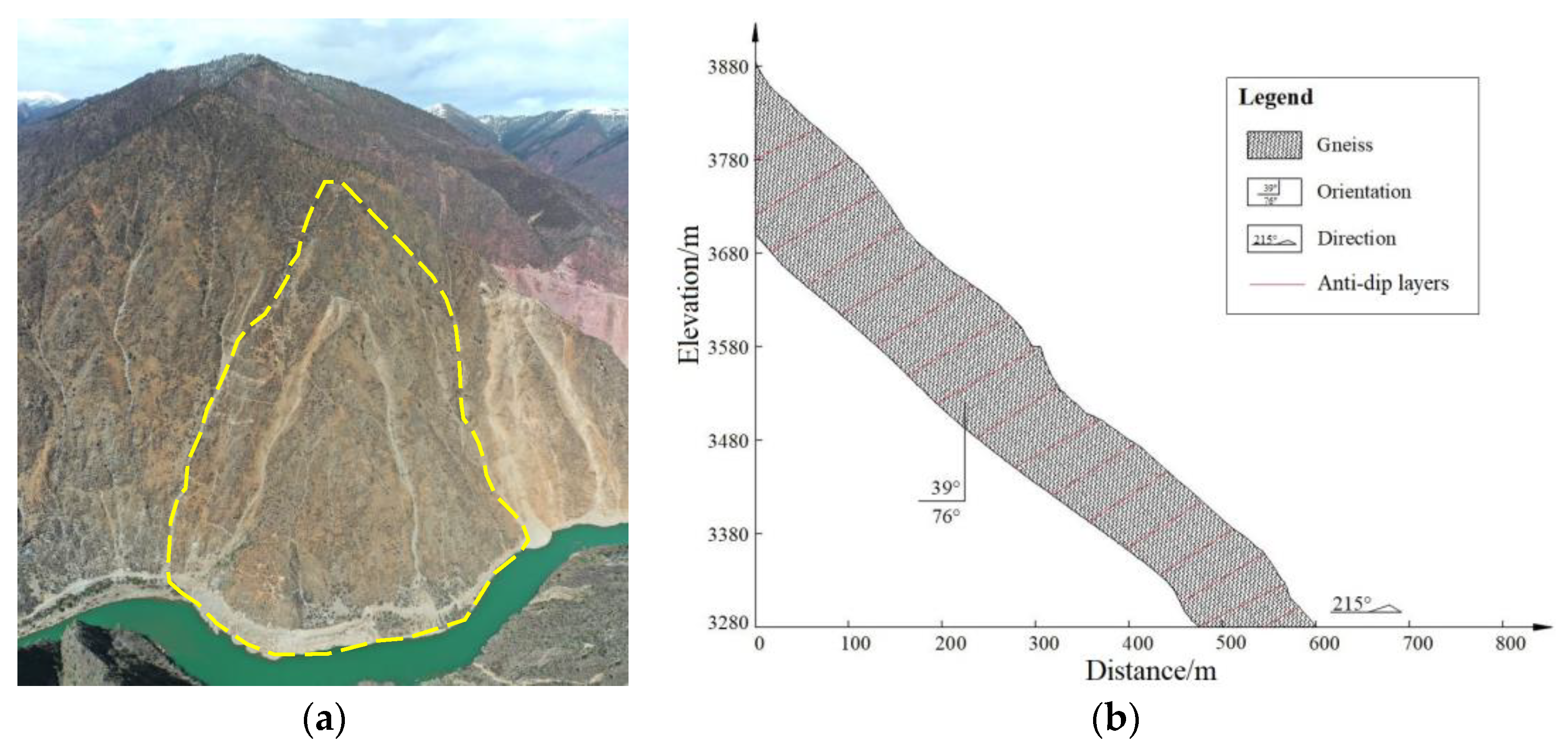


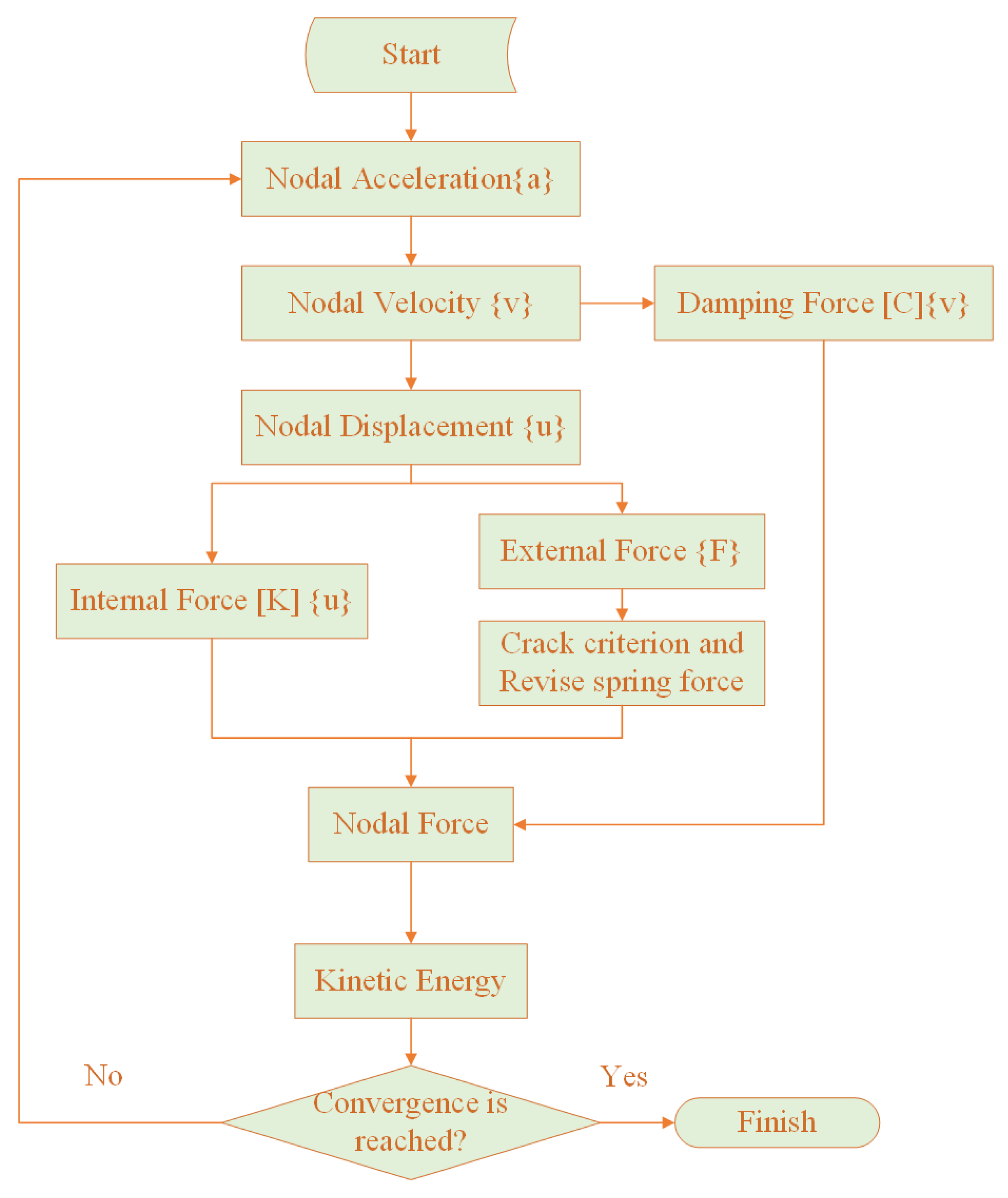
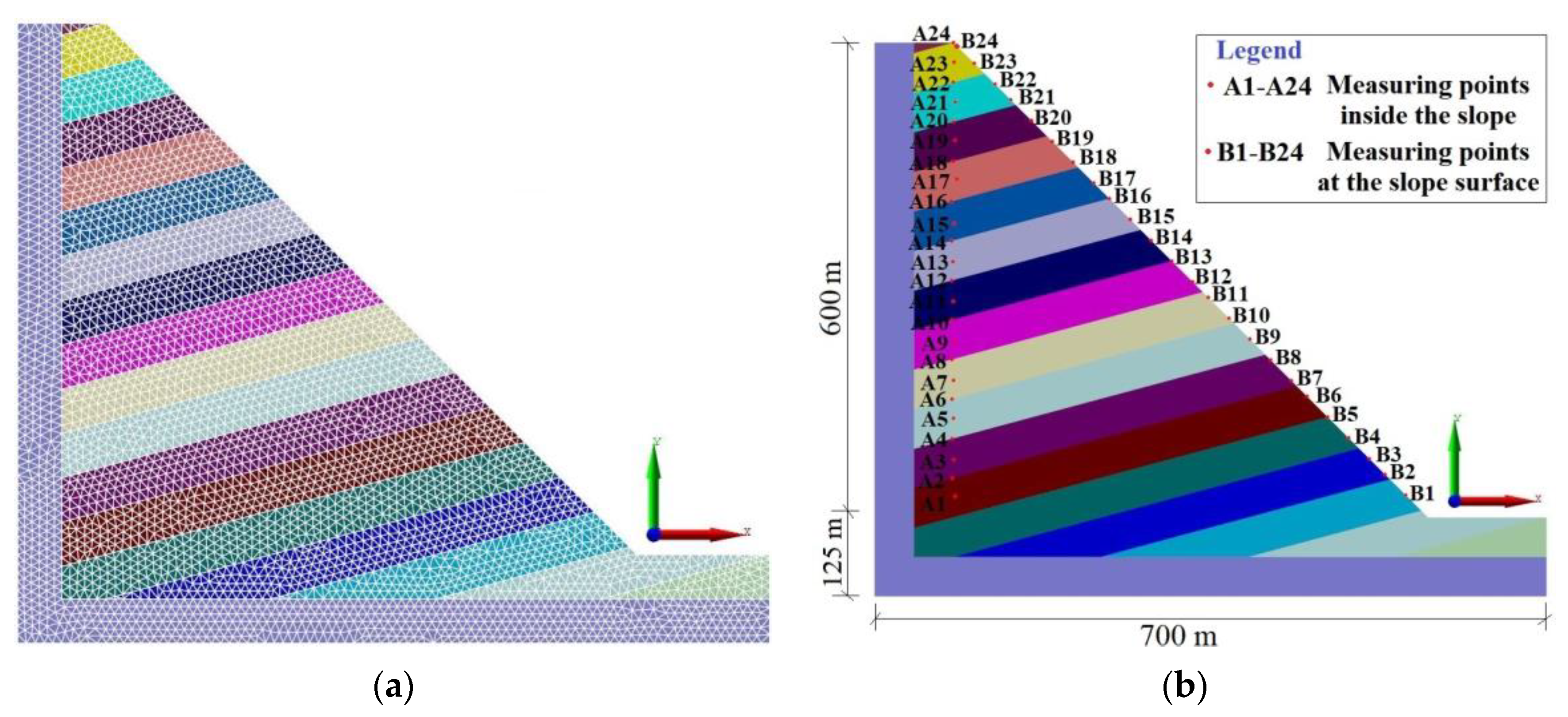
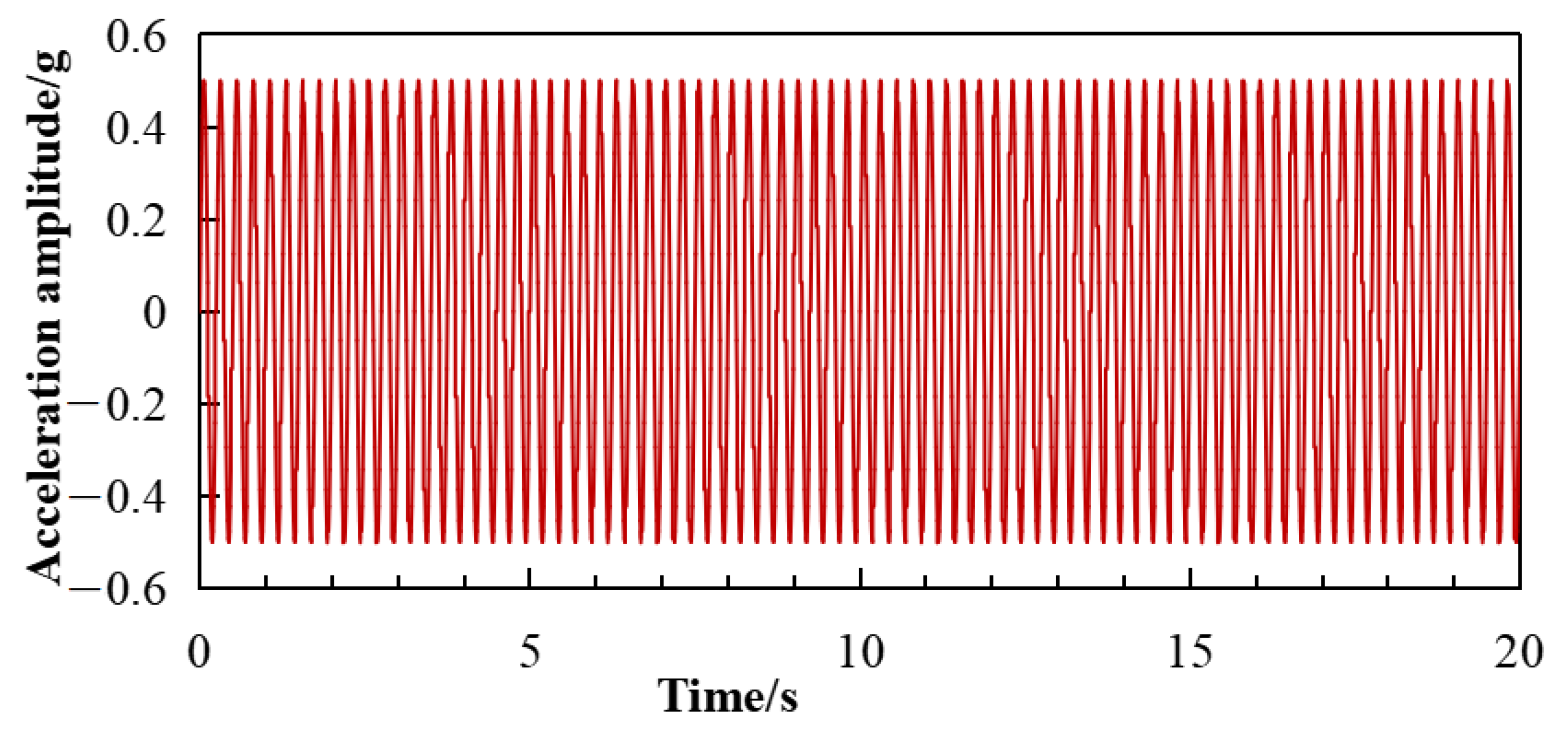
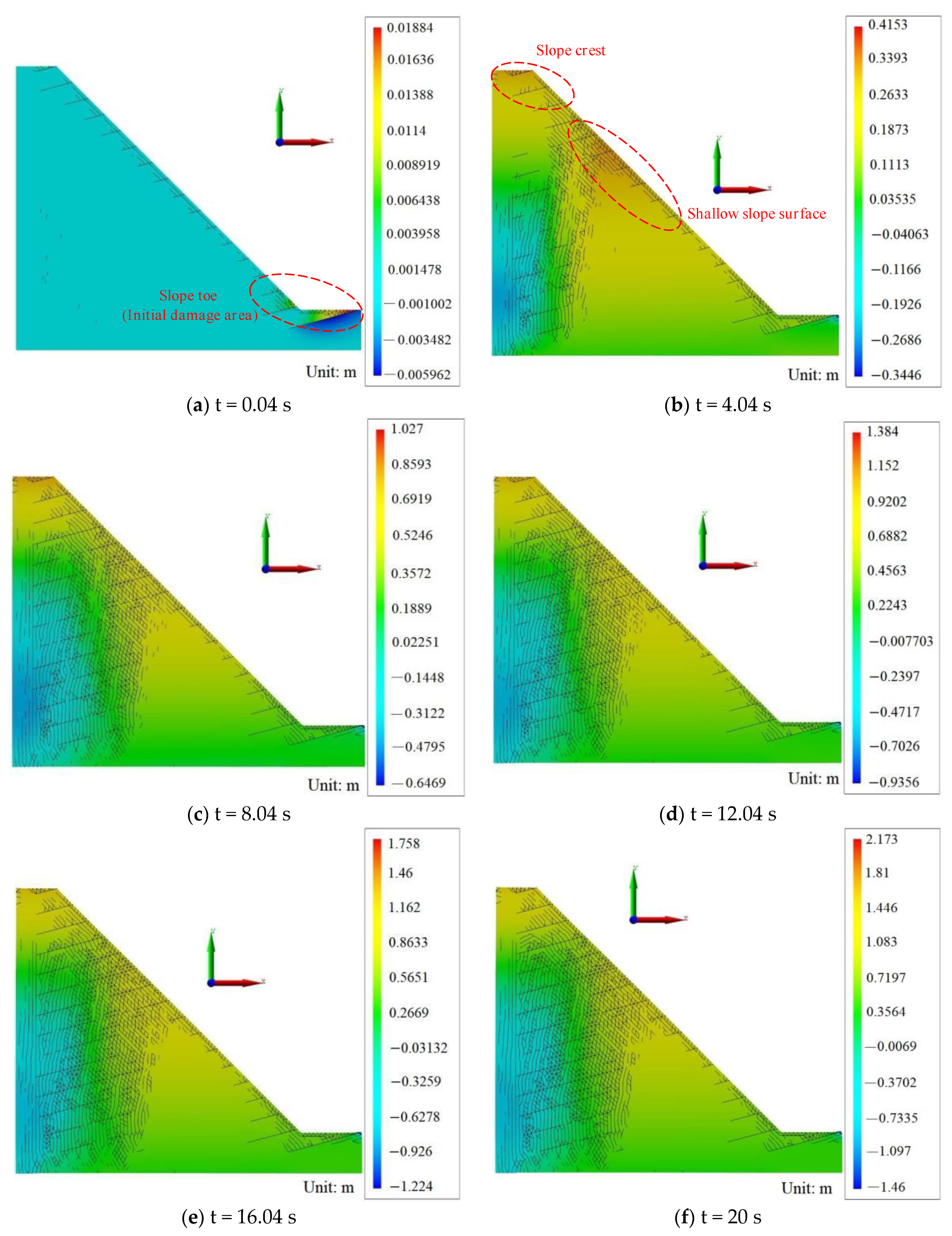

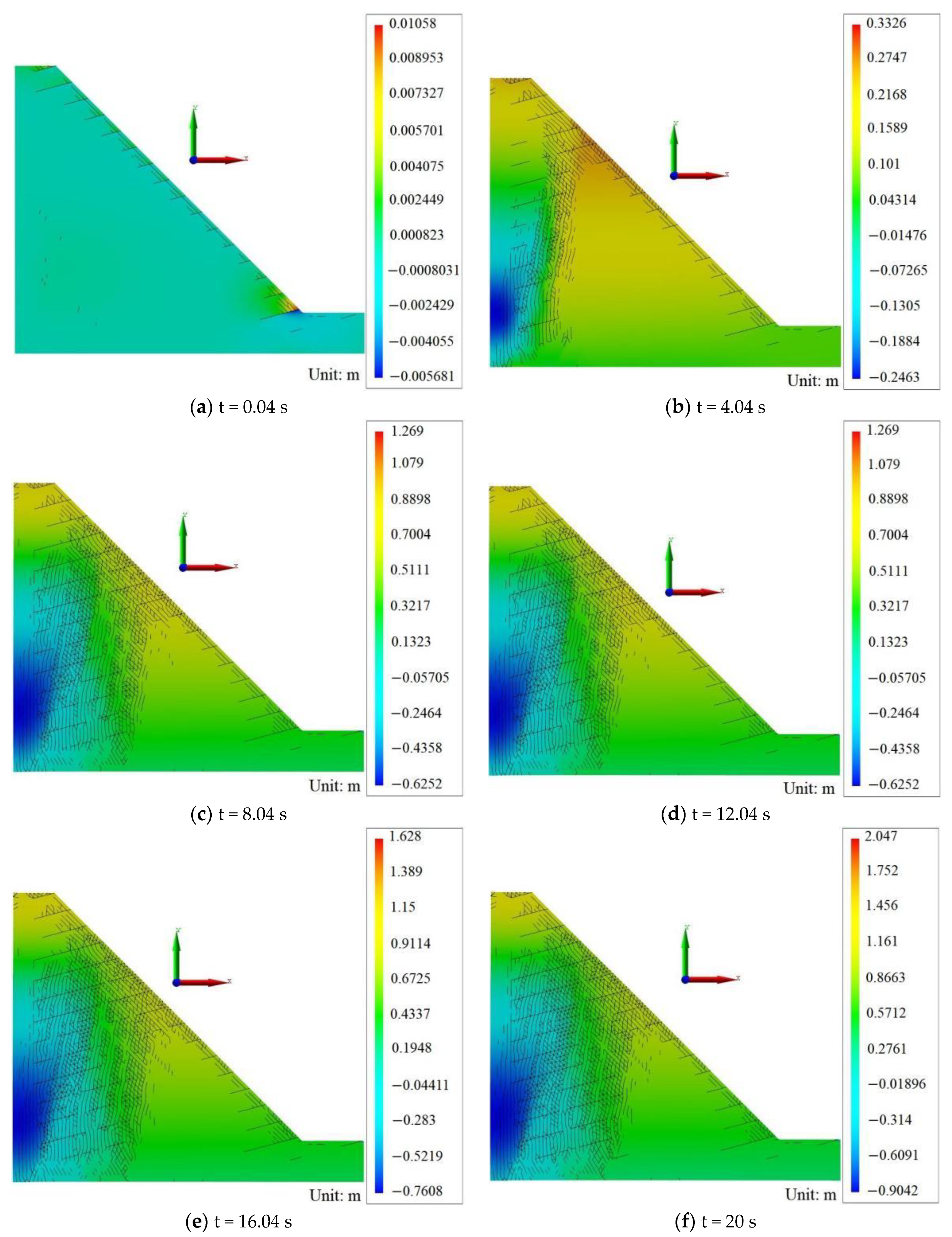

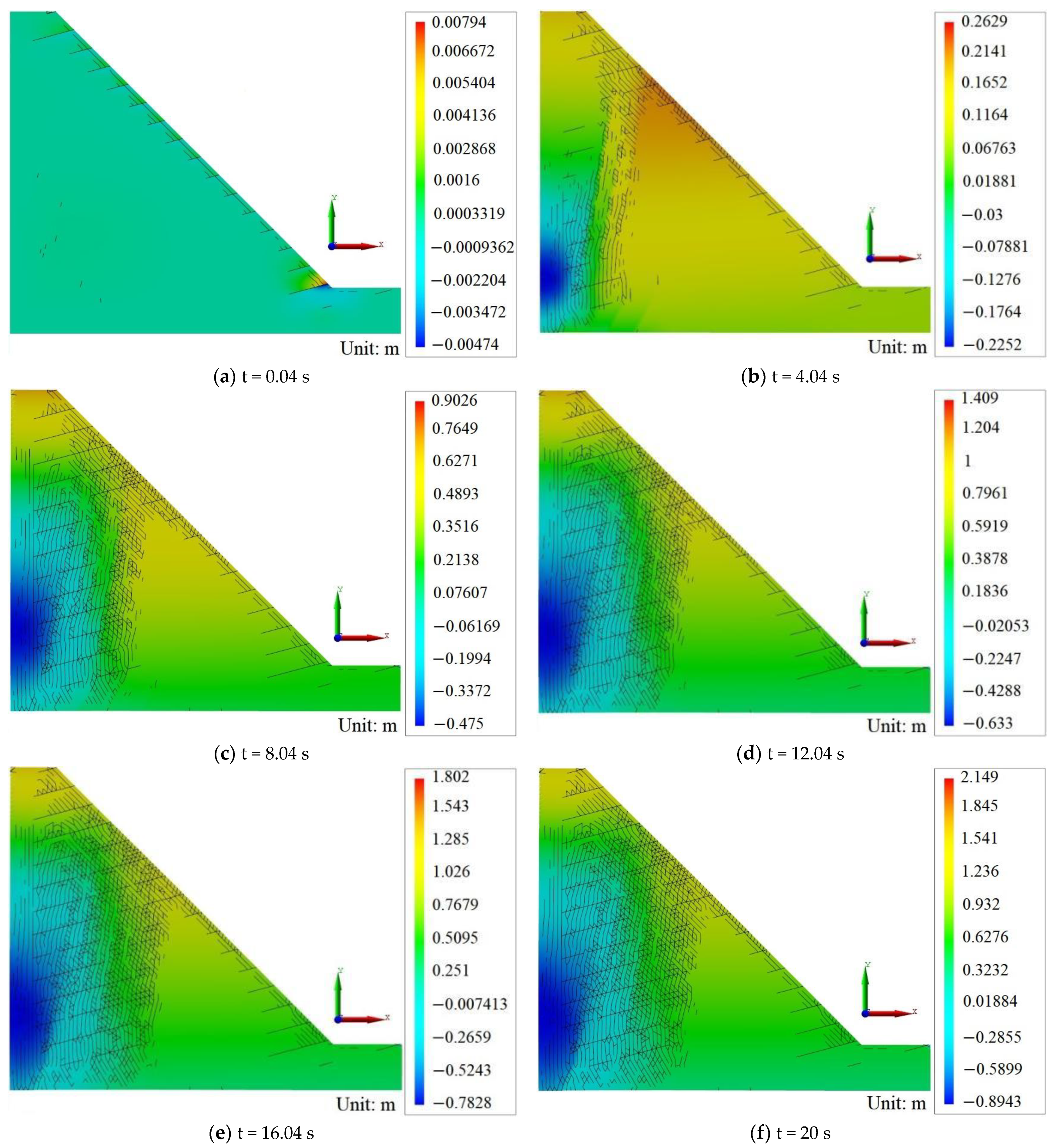
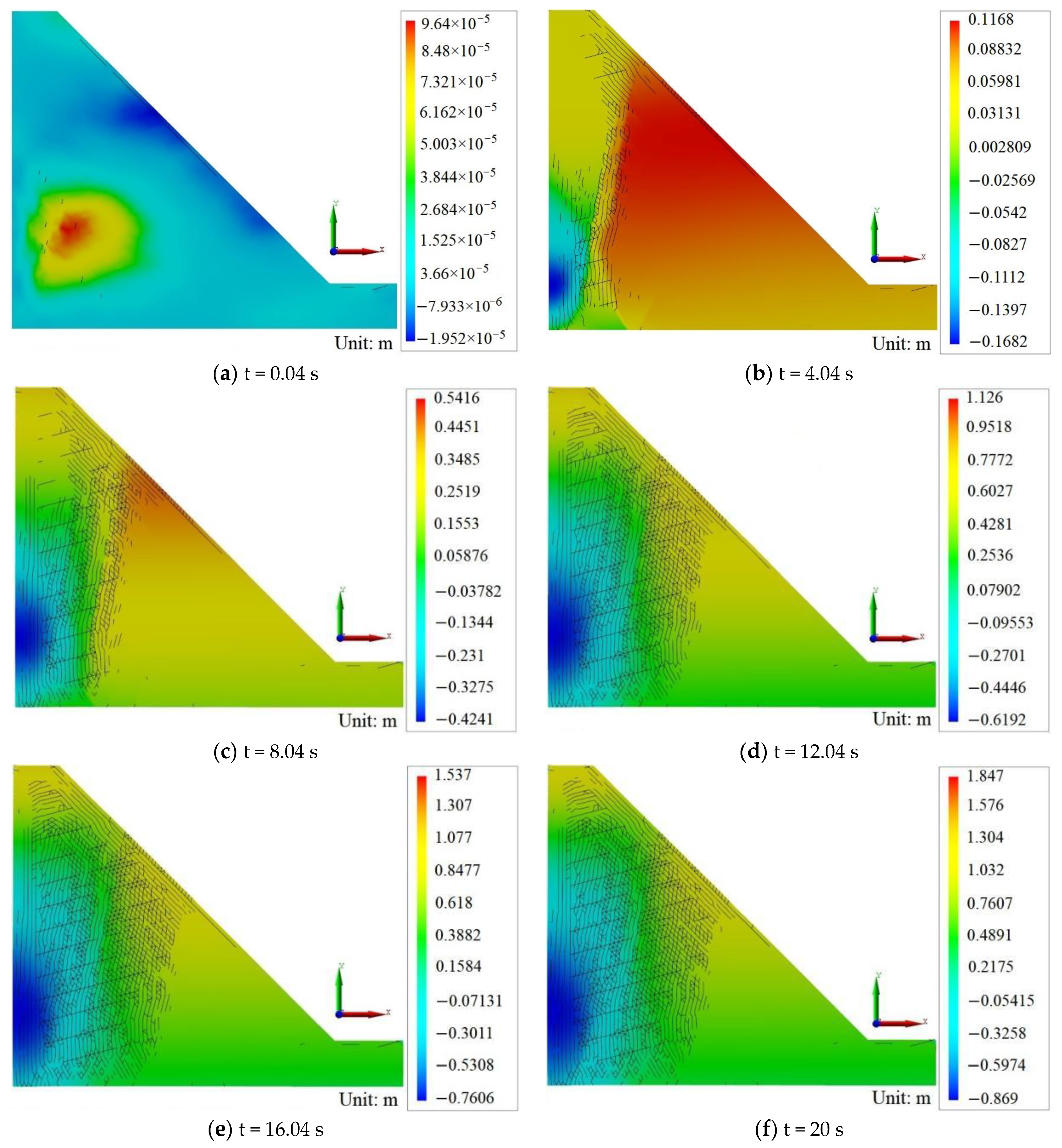
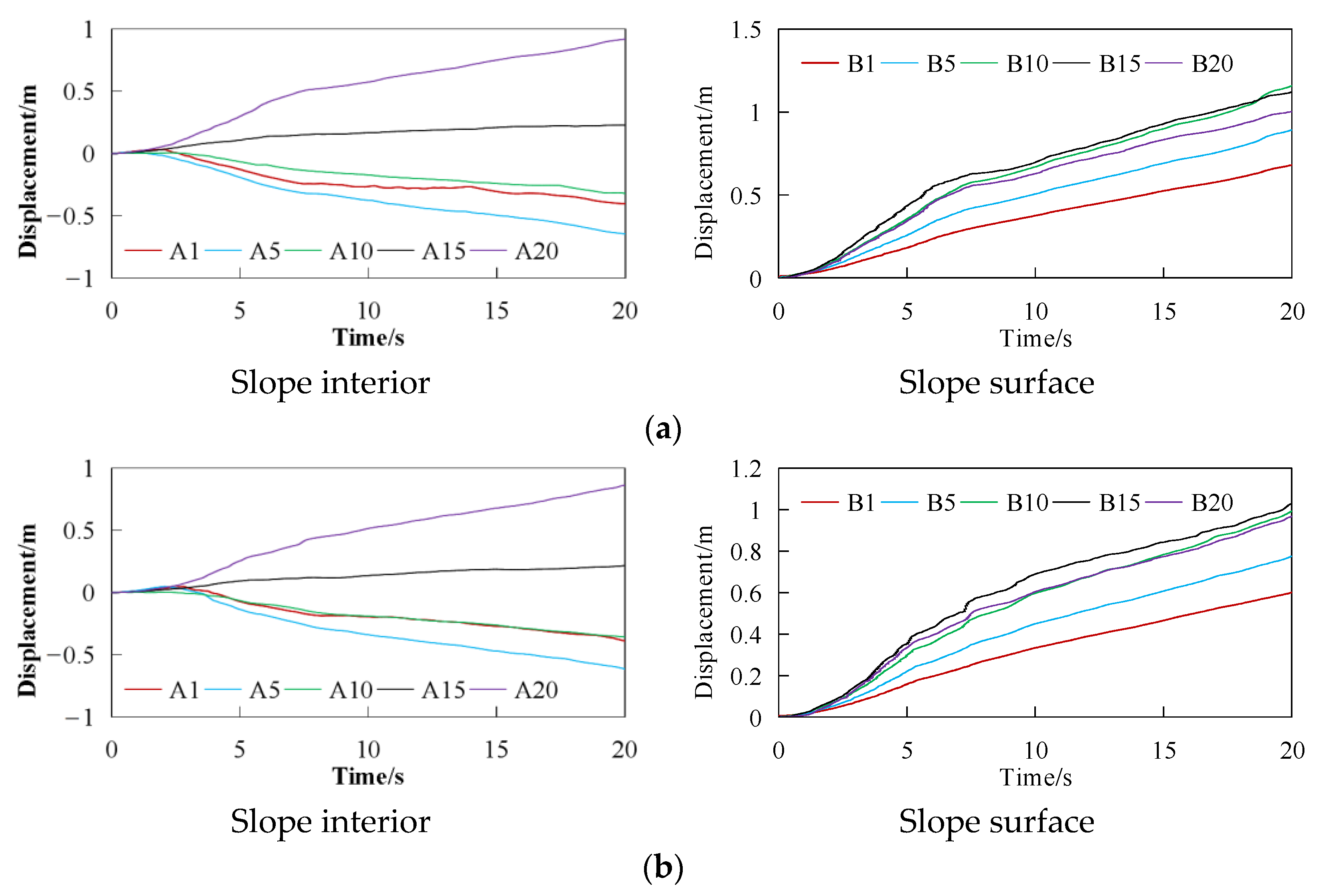

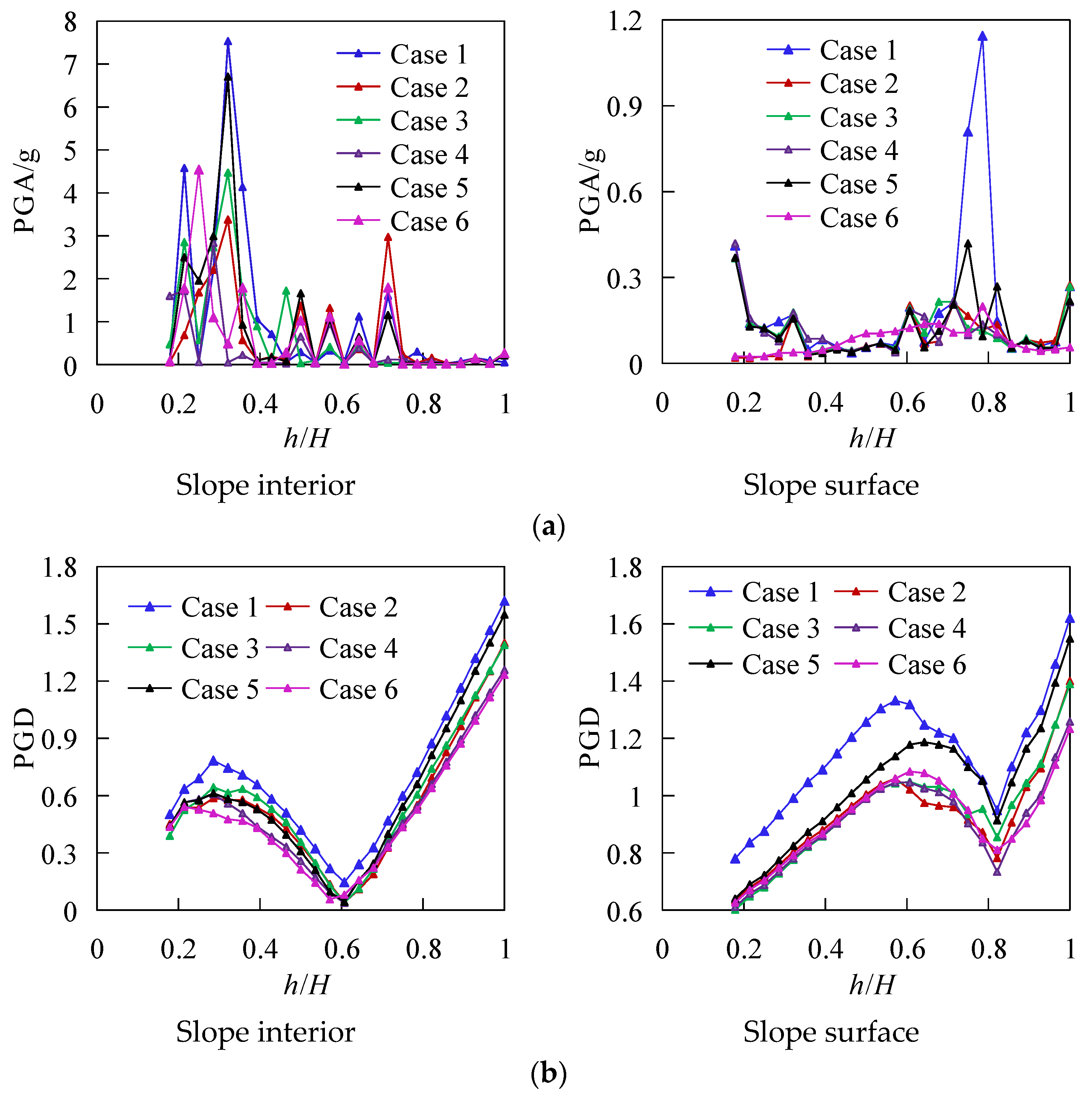

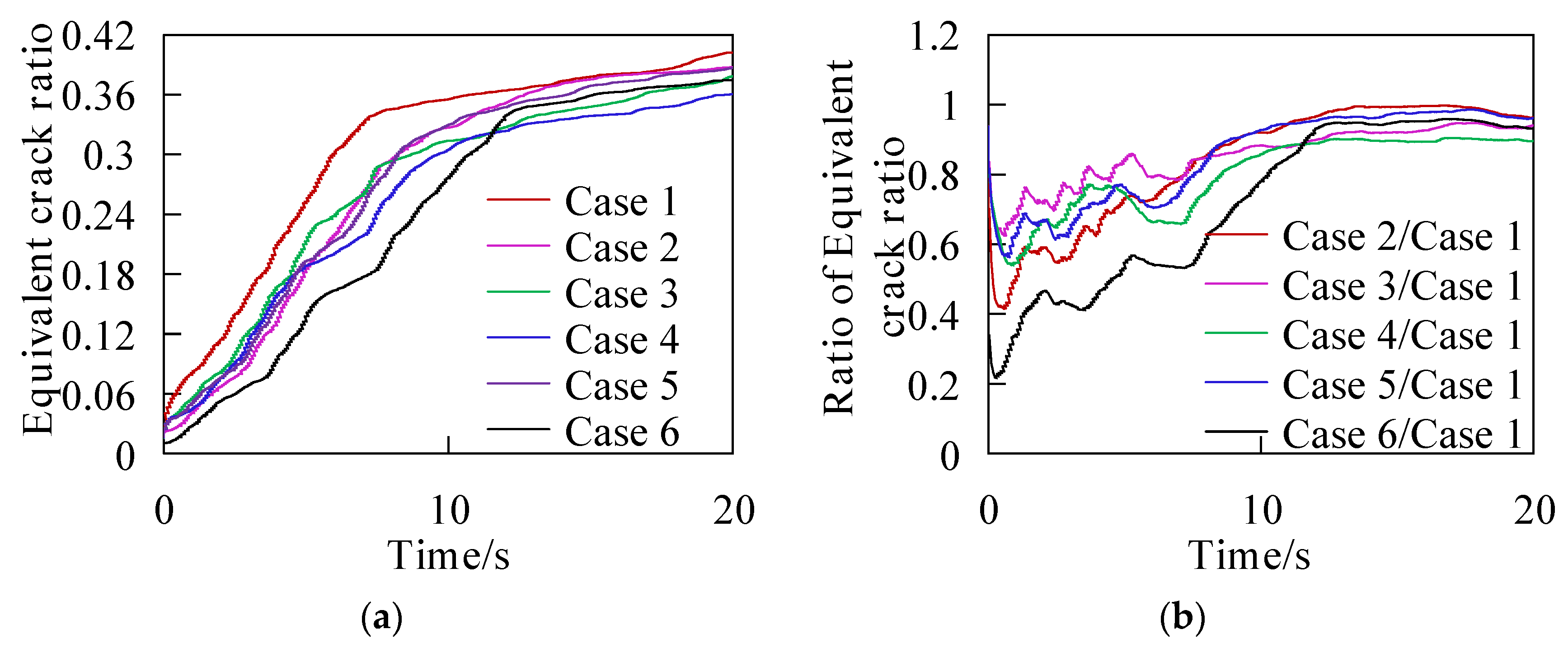
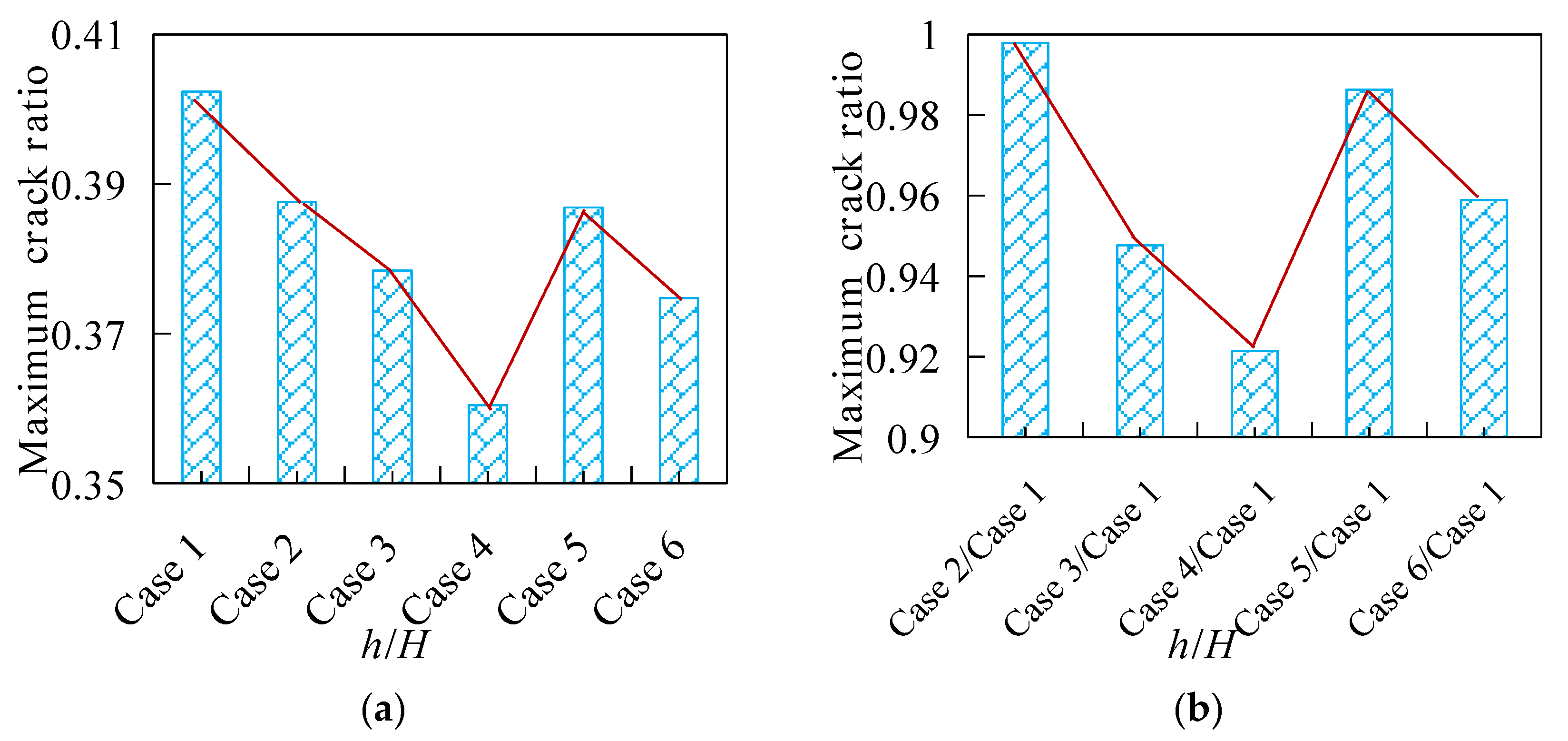

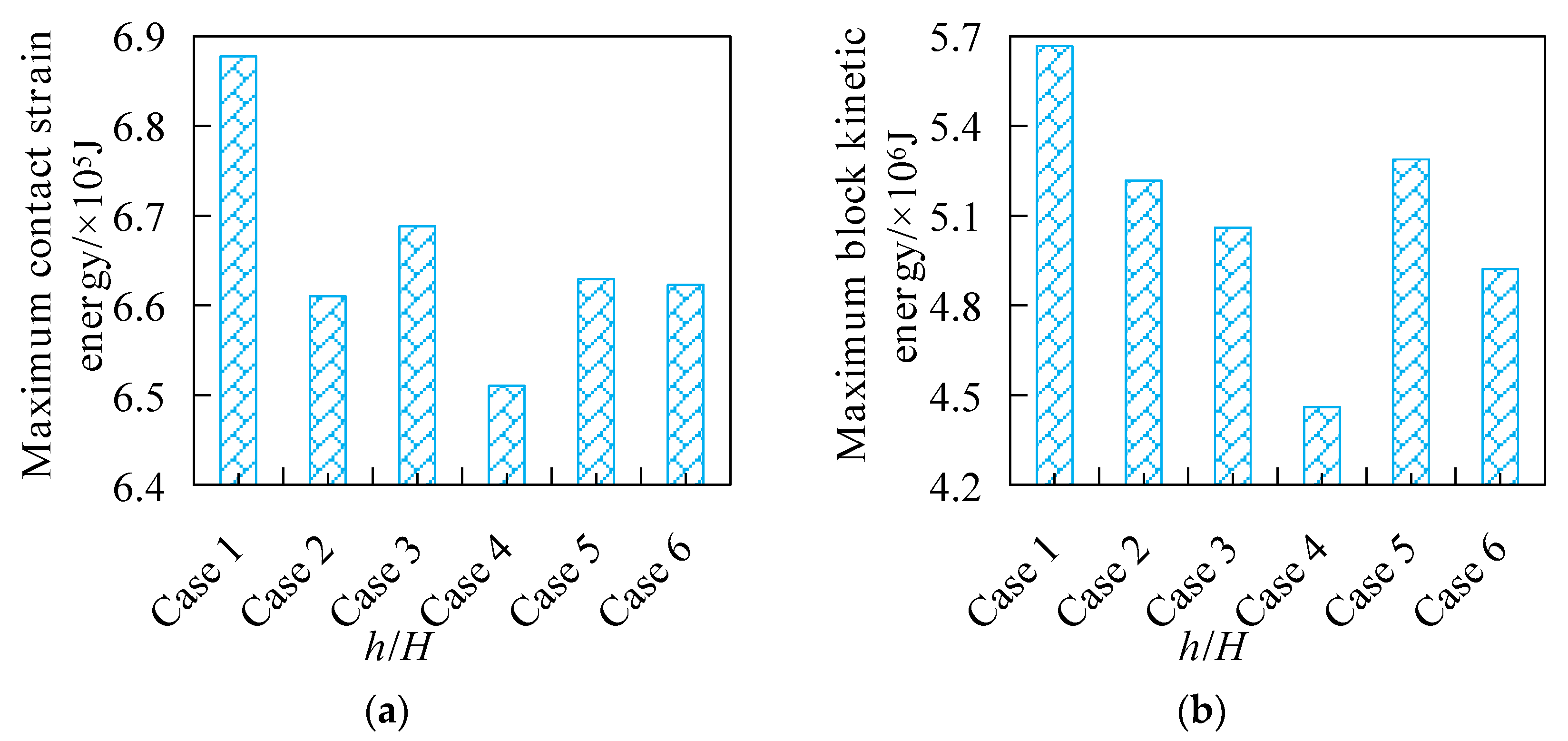
| Name | ρ [kg/m3] | E [GPa] | ν [-] | c [kPa] | T [kPa] | Φ [°] |
|---|---|---|---|---|---|---|
| Rock | 2600 | 28.7 | 0.24 | 16.9 | 8.05 | 63.2 |
| No. | Slope Strengthening Conditions |
|---|---|
| Case 1 | Slope without reinforcement |
| Case 2 | Slope after the first reinforcement (grouting reinforcement at the slope toe) |
| Case 3 | Slope after the second reinforcement (grouting reinforcement at the shallow slope surface) |
| Case 4 | Slope after the third reinforcement (grouting reinforcement at the slope crest) |
| Case 5 | Slope after the fourth reinforcement (grouting reinforcement at the shallow slope surface and slope toe) |
| Case 6 | Slope after the integral reinforcement |
| Working Condition | Name | kn [GPa/m] | ks [GPa/m] | c [kPa] | T [kPa] | Φ [°] | GfI [Pa·m] | GfII [Pa·m] |
|---|---|---|---|---|---|---|---|---|
| Before grouting reinforcement | Block interface | 300 | 300 | 16.9 | 8.05 | 63.2 | 10 | 50 |
| Layer interface | 300 | 300 | 0.1 | 0.1 | 20 | 0 | 0 | |
| After grouting reinforcement | Rock interface | 300 | 300 | 16.9 | 8.05 | 63.2 | 10 | 50 |
| Layer interface | 300 | 300 | 16.9 | 8.05 | 63.2 | 10 | 50 |
Disclaimer/Publisher’s Note: The statements, opinions and data contained in all publications are solely those of the individual author(s) and contributor(s) and not of MDPI and/or the editor(s). MDPI and/or the editor(s) disclaim responsibility for any injury to people or property resulting from any ideas, methods, instructions or products referred to in the content. |
© 2023 by the authors. Licensee MDPI, Basel, Switzerland. This article is an open access article distributed under the terms and conditions of the Creative Commons Attribution (CC BY) license (https://creativecommons.org/licenses/by/4.0/).
Share and Cite
Song, D.; Shi, W.; Wang, C.; Dong, L.; He, X.; Wu, E.; Zhao, J.; Lu, R. Numerical Investigation of a Local Precise Reinforcement Method for Dynamic Stability of Rock Slope under Earthquakes Using Continuum–Discontinuum Element Method. Sustainability 2023, 15, 2490. https://doi.org/10.3390/su15032490
Song D, Shi W, Wang C, Dong L, He X, Wu E, Zhao J, Lu R. Numerical Investigation of a Local Precise Reinforcement Method for Dynamic Stability of Rock Slope under Earthquakes Using Continuum–Discontinuum Element Method. Sustainability. 2023; 15(3):2490. https://doi.org/10.3390/su15032490
Chicago/Turabian StyleSong, Danqing, Wanpeng Shi, Chengwen Wang, Lihu Dong, Xin He, Enge Wu, Jianjun Zhao, and Runhu Lu. 2023. "Numerical Investigation of a Local Precise Reinforcement Method for Dynamic Stability of Rock Slope under Earthquakes Using Continuum–Discontinuum Element Method" Sustainability 15, no. 3: 2490. https://doi.org/10.3390/su15032490
APA StyleSong, D., Shi, W., Wang, C., Dong, L., He, X., Wu, E., Zhao, J., & Lu, R. (2023). Numerical Investigation of a Local Precise Reinforcement Method for Dynamic Stability of Rock Slope under Earthquakes Using Continuum–Discontinuum Element Method. Sustainability, 15(3), 2490. https://doi.org/10.3390/su15032490






